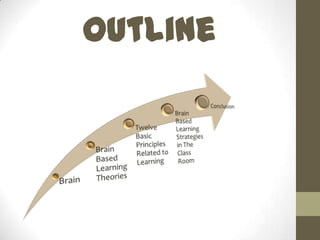Brain Based Learning
- 1. PBI UMY 2012 A Based Learning Dyah Paramitha Rahmawati Anna Wuryani Athina Rokhmah Arsyaf Nisfi Dyah Kumala Tivani Kusuma
- 2. Outline
- 4. How is your brain like? A cabbage? A raisin? A pillowcase? A grapefruit? String cheese? A walnut?
- 6. Our Brains • “LEARNING IS A DELICATE, BUT IS A POWERFUL DIALOGUE BETWEEN GENETICS AND THE ENVIRONMENT…” Robert Sylwester, A Celebration of Neurons
- 7. Brain Function The Brain Performs an incredible number of functions : Controls body temperature, blood pressure; heart rate; and breathing. It accepts sensory input from the world around it. It handles physical motion It allows you to think, dream, reason, and experience emotions. The Human Brain
- 9. What is Brain Based Learning? Taking what we know about the brain, about development and about learning and combining those factors in intelligent ways to connect and excite students’ desire to learn. Combining emotional, factual and skill knowledge into a cognitive tool.
- 12. The Twelve Principles of Brain Based Learning
- 13. 12 Basic Principles Brain Based Learning
- 14. Learning Engages the Entire Physiology • Food, water, and nutrition are critical components of thinking. 1
- 15. The Brain is a Social Brain • The brain develops better in connect with others 2
- 16. The Search for Meaning Is Innate 3
- 17. The Search for Meaning Comes Through Patterning • Use Know - Want to know - Learned cycle 4
- 18. Emotions Are Critical to Learning 5
- 19. Each Brain Perceives and Creates Parts and Wholes Simultaneously 6
- 20. The Brain is a Parallel Processor 7
- 21. Learning Involves Conscious and Unconscious Processes 8
- 22. Brain Organizes Memory In Different Ways 9
- 23. Learning is Developmental The more complex the challenge and the safer, the social and psychological environment, the greater the learning. 10
- 24. Learning is Enhanced by Challenge and Inhibited by Threat • The brain’s priority is always survival 11
- 25. Each Brain is Unique • We are products of genetics and experience 12
- 26. Lets play games my dear friends..
- 29. Brain Based Learning Strategies in The Class Room
- 34. Conclusion BBL is a learning concept to maximize the brain performing Our Brain developed 5 learning primer system : Emotional, social, Cognitive, Physical, Ref lective. (Given, 2007)
- 35. Conclusion As a Future Teacher, we should be understand about how The Fifth Learning Primer System works, Don’t let them think, if study is a nightmare even if they should press their brain performance, Make our student happy with their learning process.
- 36. That’s All, Thank You
Editor's Notes
- #5: Raisin = kismis
- #7: Delicate = sensitif, sangatlembut, mudahhancur, harushati-hati
- #8: Kontrolsuhutubuh, tekanandarah, denyutjantung, danpernapasan. Iamenerimamasukansensorikdaridunia di sekitarnya. Inimenanganigerakfisik Hal inimemungkinkanAndauntukberpikiremosi, mimpi, alasan, danpengalaman
- #10: Mengambilapa yang kitaketahuitentangotak, tentangpembangunandantentangbelajardanmenggabungkanfaktor-faktortersebutdengancara-caracerdasuntukmenghubungkandanmembangkitkankeinginansiswauntukbelajar. Menggabungkanemosional, pengetahuanfaktualdanketerampilanmenjadialatkognitif.
- #14: BelajarmelibatkanseluruhfisiologiOtakadalahotaksosialPencarianmaknaadalahbawaanPencarianmaknaterjadimelaluipolaEmosisangatpentinguntukbelajarSetiapotakmerasakandanmenciptakanbagiandankeseluruhansecarabersamaanOtakadalahprosesorparalelBelajarselalumelibatkan proses sadardanbawahsadarKita dapatmengaturmemoridengancara yang berbedaBelajaradalahperkembanganBelajarditingkatkandengantantangandandihambatolehancamanSetiapotakadalahunik
- #15: Makanan, air, dannutrisimerupakankomponenberpikirkritis. Tambahingambar food water nutrition thinkingKami adalah "holistik" pesertadidik - tubuhdanpikiranberinteraksi
- #16: Otakberkembanglebihbaik di connect dengan orang lain Ketikasiswaharusberbicaradengan orang lain tentanginformasi, merekamempertahankaninformasilebih lama danlebihefisienOtakinteraksidgn org lain
- #17: Setiap orang berusahauntukmasukakaldariapa yang dialihatataumendengar
- #18: GunakanTahu - Ingintahu - siklusBelajarBain (ApaTerbaikke College Guru Lakukan) menyarankanbekerjadari "besar" pertanyaan yang harusdijawabKetikakitamenemukanpola - interkoneksiantarapotongan-potonganinformasi, kitamenciptakanmakna.
- #19: Emosi rasa atauwarnasetiappengalaman,membuatkitainginlebihataukurangdariitupengalaman.Menciptakandanmemeliharalingkungan yangmendorongpengambilanrisiko, hidupdenganperayaandanbertanya-tanya, dan di manapelajarmerasapsikologisaman.
- #20: Empatdekadelalu, para penelitipercayabahwaotakmasing-masingbelahanotakmemilikidiskrit, fungsi-fungsikhusus. Kita sekarangtahubahwakeduasisiotakaktif di hampirsetiapkegiatan.
- #21: Edelman (1994) ditemukanketika neuron lebih di otakmenembakpadasaat yang sama, belajar, makna, danretensi yang lebihbesaruntukpelajar.
- #22: Otakdantubuhbelajarsecarafisik, mental, danafektifBagaimanaAndamemperlakukansiswadanbagaimanaAndamengizinkanmerekauntukmemperlakukansatusama lain membuatperbedaandalambelajardankeinginanuntukbelajarmereka
- #23: Memorikontekstualadalahkemampuanmemorialamkita. Hal inididorongoleh rasa ingintahu, kebaruan, aktivitassensorik, danharapan.
- #24: si kaya danlebihkomplekspengalamankita, semakinelastisotakkitamenjadi.
- #25: PrioritasotakselaluhidupStresharusdisimpanketingkat yang dapatdikelolaMemberikankesempatanuntuk "tumbuh" danuntukmembuatperubahanSemakinkomplekstantangandanaman, lingkungansosialdanpsikologis, semakinbesarpembelajaran
- #26: Kami adalahprodukgenetikadanpengalamanOtakbekerjalebihbaikketikafakta-faktadanketerampilan yang tertanamdalampengalamannyata
- #34: Tinggalmasukinreferrences, edit-edit dikitdanpembagianbagianslidenya…
- #36: Jika guru memahamibagaimanasistempembelajaran primer (emosional, sosial, kognitif, fisik, reflektif) berfungsi, makamengajarakanlebihefektifdanmerasakankegembiraanlebihbesardalammengajar.




































